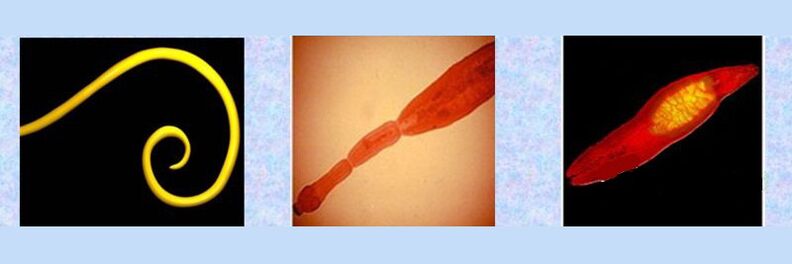Various parasites live in the human body, which interfere with the functioning of the internal organs and the whole body. People knew about helminths in ancient times, and Hippocrates first described them and the diseases associated with them.
Today, science knows about many parasites, but some of them are particularly common in the human body. They differ in their structure and mode of existence, but they must enter the human body in order to develop and reproduce.
Based on the type of structure, human parasites can be divided into several categories:
- roundworms;
- gingerbread cookies;
- tape
Let's take a closer look at the listed types of parasites found in the human body.
Characteristics of roundworms
These parasites are called nematodes. Outwardly, they resemble earthworms, but differ in their sharper ends. Their size ranges from one millimeter to 130 centimeters.
Many roundworms have a simple life cycle. After the human body is infected with nematodes, parasitic eggs are released from the intestine, which are invisible to the naked eye.
Once in the environment, the eggs ripen and then get back into the human body with dirty food, water or dirty hands. Cylindrical worms hatch from them and begin to actively develop.

All parasites found in the human body are divided into several subspecies, including:
- Pinworms. It is the most common parasite that is easily spread between people through shared objects. The formation of these nematodes in the body causes severe discomfort in the form of itching around the anus.
- Roundworms. In case of severe infection, they are dangerous to health. 25 cm worms, after maturation, the larvae spread in the blood throughout the body and internal organs.
- Trichinella. These small roundworms are up to 5 mm long. They develop in the intestines and lay larvae. After that, they penetrate the blood vessels and spread throughout the body.
- Filaria. They are mainly spread in hot countries, and their carriers are insects.
Parasites - flukes
The so-called trematodes are parasites in the human body, the symptoms of which are not always clearly visible. Flatworms up to 8 centimeters long, with holes on their bodies for feeding parasites.
Flukes have a complex life cycle and change hosts several times. The eggs develop in bodies of water and then enter the body of the mollusk for metamorphosis. When the modified larvae emerge from the molluscs, they enter the bodies of crustaceans or fish, where they are modified again.
Flukes enter the body of their final host, i. e. a person, with raw or poorly cooked meat of crustaceans or fish.
The most popular trematodes include:
- Opisthorchis. People become infected with these parasites by eating lightly salted or undercooked carp or stroganina.
- Chinese modest. It affects many fish and crustaceans living in Primorye and the waters of Japan. The parasite affects the bile and bile ducts, the pancreas and the liver.
- Paragonimiasis. It causes a dangerous disease that affects the lungs, liver, pancreas, kidneys and even the brain. People who eat poorly cooked crayfish and crayfish from fresh water become infected with it.
- Schistosomiasis. Parasites are usually found in tropical countries, and the larvae actively penetrate through the human skin during swimming, as well as when water enters the mouth from the reservoir.
Tapeworms (worms)
We have almost figured out what parasites are in the human body, but there are still tapeworms, which also come in different varieties:
- Bull tapeworm. Its length can reach up to 10 meters, and people become infected with it by eating beef subjected to low heat treatment. Housewives sometimes get infected by examining raw minced meat for the amount of added spices or salt. Once inside the body, the larva turns into saltpetre, which sticks to the intestinal wall and causes weight loss, loss of appetite, insomnia and dizziness in humans.
- Pig tapeworm. You can become infected by eating undercooked pork (up to 2 meters in length).
- Broad tapeworm. The length of the parasite varies between 6-15 meters. It is usually contracted by eating raw freshwater fish. Weakness, vomiting, nausea, abdominal pain and other symptoms appear.
- Echinococcus. A dangerous intestinal worm that can be contracted from cats and dogs carrying the parasite. In the human body, the larvae emerge from the eggs and travel with the blood to various organs, especially the liver. Subsequently, echinococcus cysts are formed, which are dangerous to health and require surgical intervention.
We looked at what parasites live in the human body, but not all of them are known helminths. Study the symptoms of a parasite infection and if you find any, see a doctor for diagnosis.






































